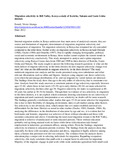| dc.description.abstract | Internal migration studies in Kenya underscore four main areas of analytical concern; they are source and destination of migrants; determinants of migration; migration selectivity and consequences of migration. Yet migration selectivity in Kenya has remained lar~ely unstudied compared to the other three. Earlier works on migration selectivity in Kenya include Ominde (1968), Oucho (1984) and Omariba (1997). Due to rapidly changing demographic, political, social and economic environment in Kenya, these studies cannot explain the current trends in migration selectivity conclusively.
This study attempted to analyse and explain migration selectivity using Kenya Census data from 1989 and 1999 in three districts of Kericho, Uasin Gishu and Nakuru. The study sought to answer the following research questions:
i) what are the main indices of migrant selectivity in the three districts
ii) does migrant selectivity change over time?
iii) what are the differentials in migrant selectivity in the three districts?
The study undertook migration rate analysis and the results presented using cross tabulations and other relevant illustrations such as tables and figures. Analysis using migrate rate shows selectivity even when the percentage distributions of in- and out migrants by varied indices are identical. The findings from the study show that age is the only index of selectivity that is consistent over time.
Analysis from this study uncovers a consistent pattern of age selectivity especially between ages 15-44, where those in late teen's (15-19) up to early thirties (30-34) are more selected for migration; selectivity declines after age 34. Negative selectivity for males is experienced at 40- 44 years but earlier at 30-34 for females. Though there is evidence of sex selectivity in migration to the three districts, it is not explicit which constrains drawing conclusions on sex selectivity of migration and need cautiously interpretation as sex selectivity no doubt call for more research. The findings generally corroborate other studies that ages 15-34 are more selective for migration; this is due to their flexibility of changing environment, entry to job market among other factors. Sex selectivity is not obviously clear, which means that we cannot establish universal sex differentials for the three Districts as noted in other studies (Oucho, 1981;
Ominde, 1968).
By analysing the differences in the distribution of education by age and sex, it is evident that for both males and females, migration was selective of those without education and those with secondary education and above. Considering the rural-rural migration stream to the Rift Valley, migration is selective of uneducated or semi-educated persons. Those without education probably end up doing manual work on farms while those with education take formal employment in industries, government offices, among others. From the findings, migration selectivity in relation to education persists overtime. The findings from the analysis show that, especially for those with secondary education and above, migration is highly selective among them, a feature that persisted over the two censuses. The evidence from the analysis shows education plays a major role in selecting individuals for migration.
Regarding occupation selectivity, this study concludes that paid work is a major factor in selection for migration. Majority of the migrants engage in paid work while some undertake agriculture both small scale and commercial agriculture. Agriculture is the major attraction to the three districts. Findings from this study suggest that migration is most selective of monogamously married, a phenomenon suggestive of their disposition to shoulder family responsibilities expected of them by their spouses and children.
Previous studies by de Laat (2005), note that split migration occurs among married couples, the husband often migrating first followed by the wife who works to shoulder family needs, such as food, clothing, housing, education and health, while men use a portion for savings and investment in addition to family needs (10M, 2005). This is a possible explanation of the trends witnessed in this study. | en_US |

